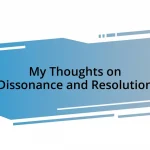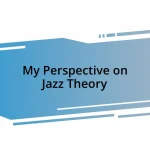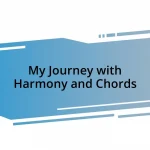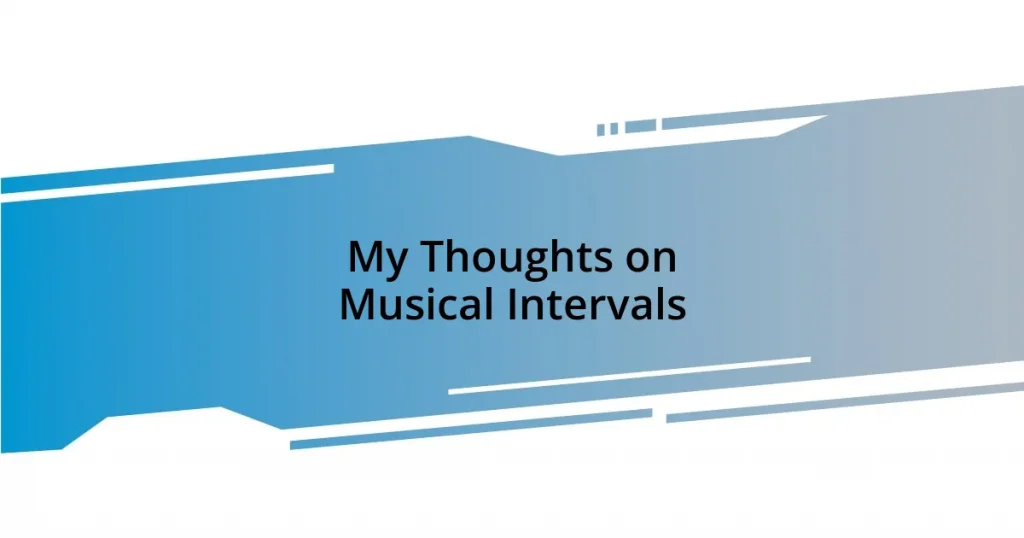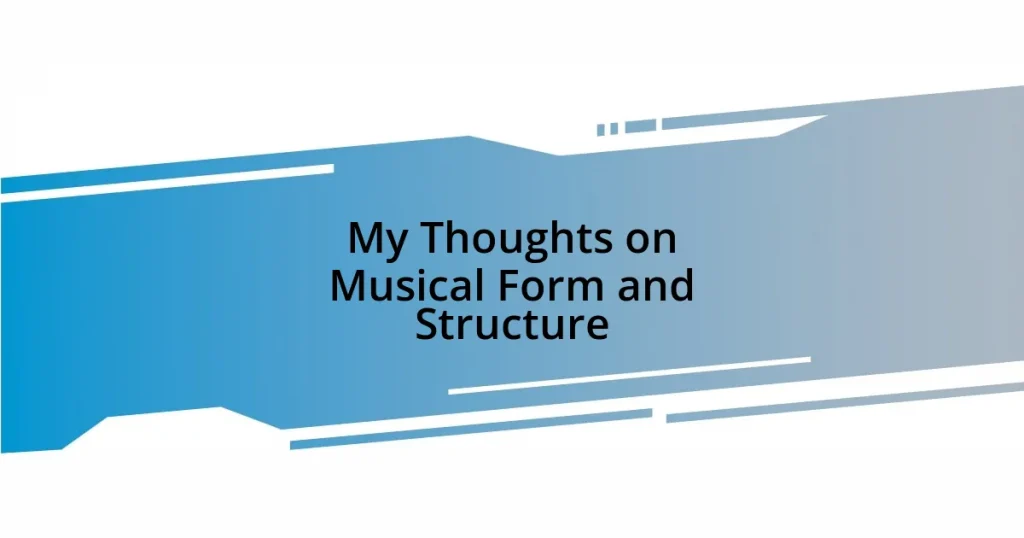Key takeaways:
- Musical intervals evoke distinct emotions, such as major thirds feeling joyful and minor sixths being melancholic, influencing the listener’s experience.
- Understanding the characteristics of different intervals—major, minor, perfect fifth, diminished, and augmented—enhances composition, improvisation, and emotional expression in music.
- Practical exercises, like creating melodies with specific intervals and using ear training apps, improve interval recognition and deepen musical intuition.
- Musicians often misidentify intervals, neglect emotional impacts, and overlook context, leading to confusion in composition and diminished expressiveness.
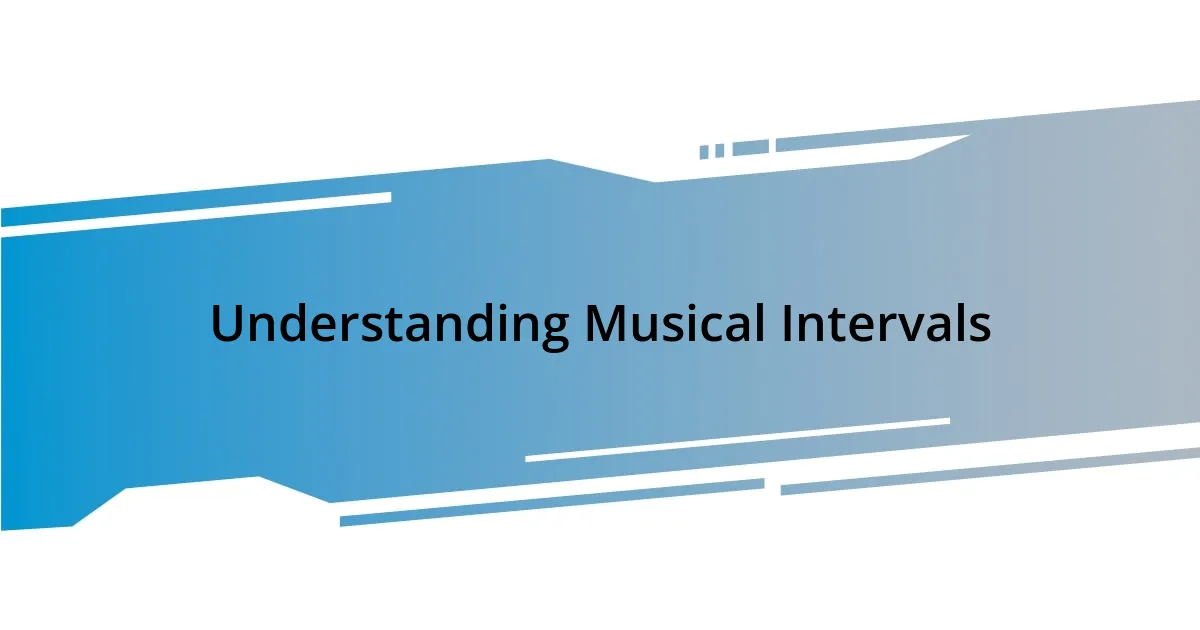
Understanding Musical Intervals
Understanding musical intervals is like discovering a secret language within music. When I first learned about intervals, it fascinated me how two notes, when played in harmony, could evoke such varied emotions. Have you ever noticed how a major third sounds cheerful while a minor sixth can feel a bit melancholic? It’s incredible how these simple relationships shape our feelings in music.
There’s something deeply personal about how intervals resonate with us. For instance, I vividly remember the first time I played a perfect fifth on my guitar. The sound felt so balanced and open, as if it was inviting me to explore further. I often find myself reflecting on how different intervals change the mood of a piece. It makes me wonder, what moments in music stick with you because of their unique intervals?
Delving deeper into intervals can truly transform your musical experience. I recall grappling with dissonant intervals, like the tritone. At first, it felt jarring, but with time, I appreciated how that tension adds depth to compositions. Do you feel the urge to explore beyond familiar sounds? Understanding these relationships not only enhances your playing but can also enrich your appreciation for music’s emotional landscape.
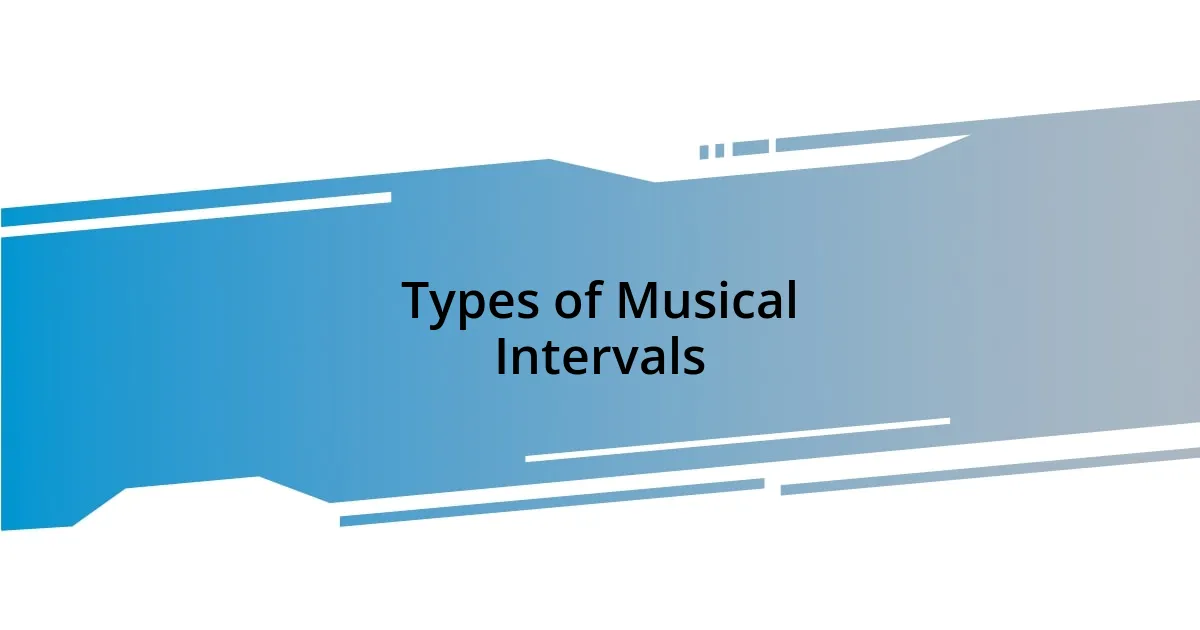
Types of Musical Intervals
Musical intervals can be categorized into several types, each with its unique character and feel. For example, I find that major and minor intervals, like the major third and minor third, are foundational in understanding harmony. The major third feels happy and bright, while the minor third, in contrast, can evoke a more somber or introspective emotion. I remember writing a piece where I deliberately played with these intervals to express a journey from joy to longing, which deeply resonated with my audience.
One of the more intriguing intervals is the perfect fifth. It’s often described as a stable and harmonious interval, reminiscent of strength and resolve. I experienced this firsthand during a choir rehearsal when we sang a piece that relied heavily on fifths. The unity created by that sound was palpable, almost like a warm hug enveloping us. Conversely, I’ve had moments with diminished and augmented intervals, which create suspense and tension. There’s a level of anxiety they invoke that can be both exciting and unsettling. I remember listening to a contemporary piece that used these intervals to build up an incredible sense of urgency—it left me breathless!
Here’s a handy comparison table summarizing the types of musical intervals:
| Interval Type | Characteristics |
|---|---|
| Major | Bright, happy sound |
| Minor | Dark, melancholic sound |
| Perfect Fifth | Stable, harmonious |
| Diminished | Tension and suspense |
| Augmented | Exciting, unsettling |
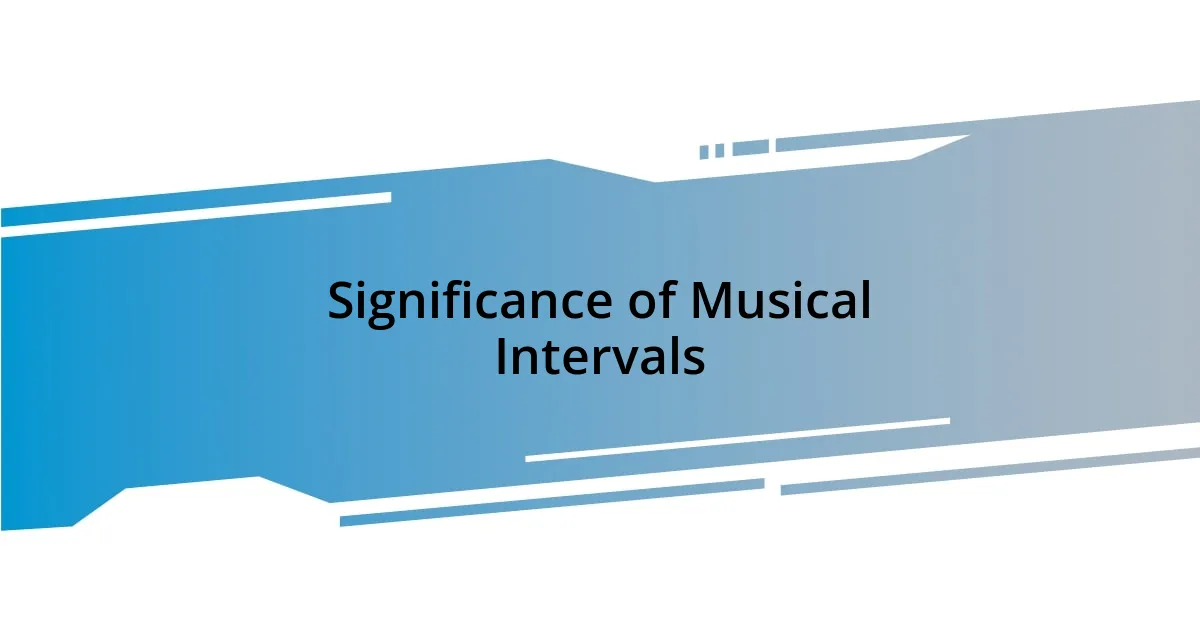
Significance of Musical Intervals
Musical intervals hold significant weight in both composition and performance, shaping the listener’s emotional experience. I still remember the first time I explored the relationship between intervals while composing a song. I felt like I was painting with sound. The tension created by a tritone gave my piece an edge I hadn’t anticipated, drawing listeners in with a swirl of emotions, causing them to sit at the edge of their seats. It was a beautiful revelation that reinforced how critical these intervals are in influencing the overall mood and narrative of music.
To illustrate the impact of intervals, consider the following points:
- Emotional Resonance: Different intervals evoke distinct feelings. For instance, the minor second often conveys tension, while the major sixth can evoke warmth.
- Cultural Context: Certain intervals have unique meanings in various musical traditions, enhancing their significance beyond mere sound.
- Formative Influence: Understanding intervals is crucial for musicianship, enabling more creative expression and improvisation.
- Structural Foundation: They form the basis of harmony and melody, making them integral to musical architecture.
- Mood Shaping: Composers utilize intervals intentionally to craft emotional journeys, guiding listeners from one feeling to another.
By dissecting intervals, we unfurl layers of meaning that enrich our musical experiences, transforming how we both create and appreciate music.

How to Identify Intervals
Identifying musical intervals is an engaging way to deepen your understanding of music. When I first started, I remember using a piano to help me find intervals. Striking two notes and listening closely made me realize how different sounds can blend or clash to create unique emotions—a major third always had a joyful feel, while a minor second felt like tension pulling at me. Have you ever noticed how a little shift in pitch can evoke such a strong reaction? It’s truly fascinating!
Using tools like a piano or guitar can make the identification process even more straightforward. Simply play two notes in succession and listen for the distance between them. I recall once sitting with a friend, testing our ears by playing intervals and challenging each other to identify them. That friendly competition not only improved our skills but also created a fun atmosphere where we celebrated our successes—and laughed off our mistakes! Have you ever tried something similar? It’s amazing how actively engaging with intervals can enhance your musical intuition.
Another effective method for identifying intervals involves singing. I often find that singing the notes helps internalize the sound and feel of the interval. For instance, when I sing a perfect fifth, it has a resonant quality that feels empowering. I still practice this technique, and I encourage you to do the same. Can you envision how physically learning these sounds might deepen your appreciation for music? By actively participating, we become not just listeners but collaborators in the musical journey.
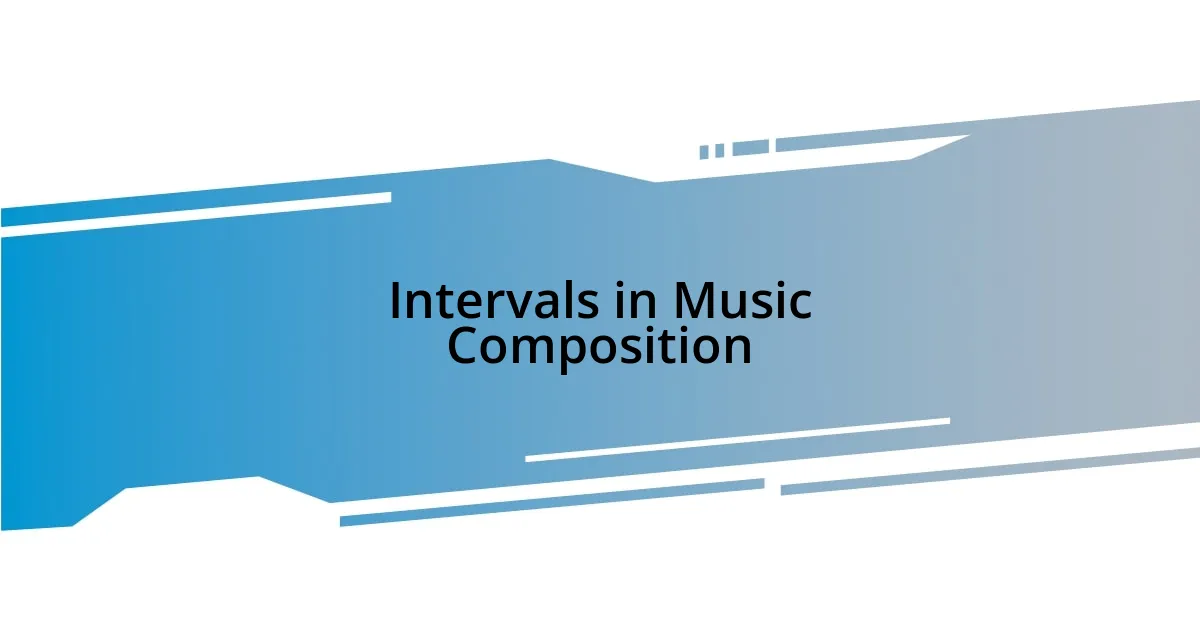
Intervals in Music Composition
When I think about intervals in music composition, I’m often reminded of how they can transform a simple melody into something extraordinary. I once composed a piece that started with just a major scale, but as I added intervals—like a minor sixth—I could feel the emotional depth growing. Each interval seemed to guide the piece in a new direction, creating moments that were both surprising and profoundly moving for my audience. Isn’t it remarkable how a slight shift in pitch can change the entire tone of a composition?
It’s like building with blocks; the right intervals serve as the foundation upon which the entire piece stands. For instance, I find that alternating between consonant intervals, which feel stable, and dissonant ones, which introduce tension, creates a dynamic musical landscape. I still vividly remember the thrill of layering contrasting intervals, leading to a resolution that left both me and my listeners breathless. Can you recall a time when a piece of music made you feel something you didn’t expect?
Ultimately, intervals are the brushstrokes in the painting of musical creation. They allow composers to craft stories without words and evoke feelings that linger long after the final note. In my own experience, exploring the intricate relationships between intervals opened up new avenues of expression in my music. How do you think your relationship with intervals has shaped your own understanding and enjoyment of music? I believe that delving into this nuance not only enhances our compositions but also deepens our appreciation for the richness of sound.
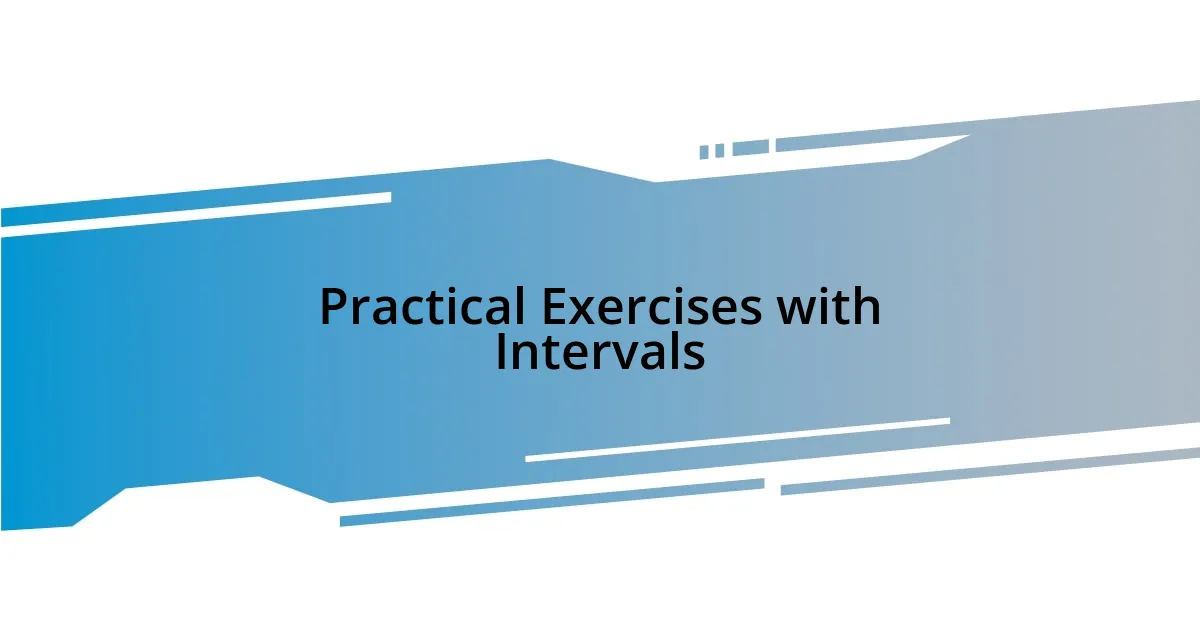
Practical Exercises with Intervals
To really get a feel for musical intervals, I’ve found that practical exercises make a world of difference. For instance, I often create simple melodies using various intervals and then play them back. It’s a delightful process to hear how each interval adds flavor and character, turning an unadorned tune into a lively piece. Have you ever tried this with your own compositions? It can be both eye-opening and heartwarming to experiment in this way.
One of my favorite exercises involves using backing tracks or metronomes. I’ll often set one up and improvise over it, focusing on a specific interval for a session—like playing only thirds or sixths. The challenge of sticking to just those intervals pushes me to think creatively and make the most out of less. It’s like solving a musical puzzle. I still remember the joy of crafting a solo that hugged the limits of a minor seventh, which made my improvised performance feel both rich and thrilling. Can you recall a moment when a particular restriction led to your most inventive ideas?
Lastly, I highly recommend using interval ear training apps or websites. I regularly challenge myself with these tools, and they have the uncanny ability to sharpen my listening skills over time. Each time I accurately identify an interval, I feel a sense of achievement that energizes my practice. Have you utilized any digital resources for honing your musical skills? It’s amazing how technology can enhance our understanding, making the process more interactive and engaging.

Common Mistakes with Intervals
One common mistake I often see with intervals is the tendency to misidentify them, especially for beginners. I remember my early days of guitar playing when I struggled to distinguish between a perfect fourth and a minor third. It’s not just a matter of names; getting it wrong can lead to confusion in chord construction or melody writing. Have you ever found yourself scratching your head over interval names, only to realize you were playing something entirely different? It can be quite humbling!
Another aspect I frequently encounter is neglecting to explore the emotional impact of intervals. I used to focus solely on the technical side of things, but I discovered that failing to recognize how specific intervals convey feelings can limit a piece’s expressiveness. For instance, using a diminished fifth can create tension, while a major sixth tends to sound hopeful. When was the last time you considered what emotions your chosen intervals were conveying? Embracing this aspect can really elevate your music.
Lastly, many musicians overlook the importance of context in relation to intervals. I’ve been guilty of treating intervals as standalone elements without considering how they interact with chords and melodies. This misunderstanding can lead to an unbalanced sound in compositions. I still recall a time when incorporating the same interval in different contexts changed the entire feel of my song. Have you experienced that realization? It reinforces the idea that intervals are not just about the distance between notes, but also about how they fit into the bigger picture of musicality.







